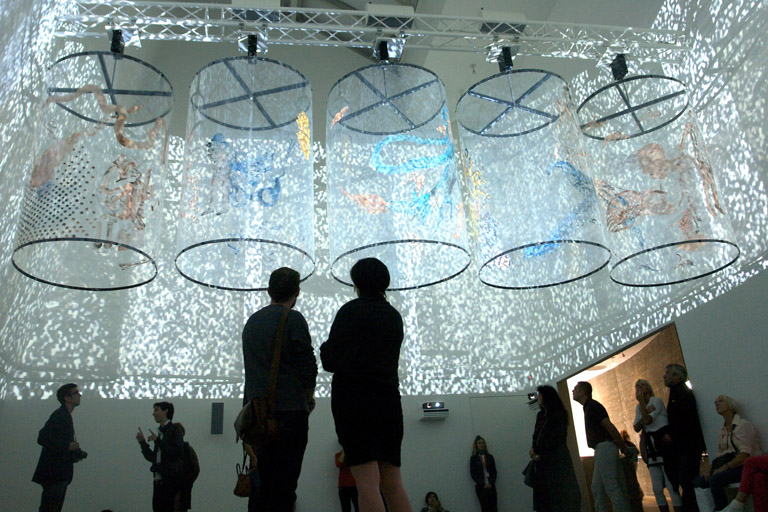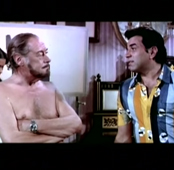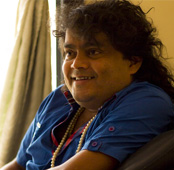-
 Audience at Nalini Malani's installation 'In Search of Vanished Blood.'
Audience at Nalini Malani's installation 'In Search of Vanished Blood.'
Is the recent boom in video art just a passing fad? Or is it indicative of a trend that’s here to stay? Here is Girish Shahane’s guided tour of the scene.
While the use of video is not a new development in Indian art, it has recently gained such wide acceptability that it is unusual these days to find any large exhibition of contemporary art that does not feature work in that medium. Consider some of the exhibitions that have been mounted in major cities: At Colaba’s Chatterjee & Lal gallery, Bangalore-based Kiran Subbaiah produced a 43 minute epic called Narcissicon. It was scripted, photographed and directed by the artist himself, who played all the characters that appeared on screen, often two or three at a time.
Excerpt from Narcissicon, by Kiran Subbaiah:
At Galerie Mirchandani + Steinruecke, the twenty-something Surabhi Saraf’s videos were composed of multi-image grids. Each small square within the grid showed the same shot of the artist going about some daily activity, like cooking or folding clothes. The catch was that, while the small squares played the same sequence, they did not play the same frame simultaneously. Carefully choreographed, and paired with specially designed soundtracks, Saraf’s grids shimmered and danced as different parts of the shot played across and down the grid.
FOLD by Surabhi Saraf:
At Chemould Prescott Road, Vishal K. Dar collaborated with Kaushik Bhaumik and Siddhartha Chatterjee on The Rise of the BROWNationals. One of the videos composed was of an inverted image of the Republic Day parade. The artists had intervened in a simple yet effective way with officially broadcast footage to question the militaristic emphasis of the annual ritual.
Vishal K. Dar’s The Rise of the BROWNationals | Girl on a Swing:
The Rise of the BROWNationals | The Carousel of Dharma:
Shine Sivan’s show at Gallery Maskara included a graphic video of the artist masturbating in a forest. It played behind a partition in a section of the gallery that had been strewn with leaves and branches to echo the landscape seen in the video.
Over in Delhi, The Skoda Prize show at the National Gallery of Modern Art, which I was involved in organizing, had the artist collective CAMP screening a video created for the UK’s Folkestone Triennial in 2011. CAMP had provided cameras to members of a volunteer coastguard unit based in that English town, asking them to film what they saw through telescopes. After crowd-sourcing the footage, CAMP edited it down to one hour. Everything from local bird species, to submarines, to the coast of France, appeared on screen, often in a moody haze, accompanied by commentaries filled with inimitable English humour.
The Kiran Nadar Museum of Art in Saket opened a show of seven contemporary women artists in late January this year. One of those seven, Sonia Khurana, had interviewed her grandmother about memories of Partition, and combined this with archival footage and a personal voice-over analyzing the old woman’s recollections.
Video might now be a familiar medium used dexterously by Indian artists, but it arrived late on the scene. Indians raised in the late sixties and seventies, even those born into affluent households, didn’t grow up filming home movies on Super 8, the way so many of their counterparts in the US and Europe did. Celluloid, even 8 mm stock, was heavily taxed, and spare parts for cameras difficult to find. As a result, though artists like Tyeb Mehta, Akbar Padamsee and M. F. Husain were deeply interested in cinema, they didn’t use the medium frequently.
When portable video recorders arrived, they provided a cheaper option to capture moving images, and by the 1990s many Indians owned handycams. Artists who had been trained as painters, began experimenting with video as an extension of their practice. There was no market for such work locally, but galleries and museums abroad had an established tradition of exhibiting video. Indian video art was shown more often internationally than at home in the course of the 1990s. Now, of course, most human beings on the planet walk around with video recorders in their pockets or handbags. Little wonder that video has become an important medium through which Indian artists interpret their world.
There are no sharp lines demarcating video art from, say, experimental documentary, or short fiction. Works by Ashish Avikunthak and Kabir Mohanty, who call themselves film-makers, and usually shoot using 16 mm or 35 mm stock, have regularly been shown in galleries and museums. This aligns with the idea that anything can be art, provided it is labeled as such, or displayed in conditions normally associated with art viewing. Having said this, there are broad differences, based on the variant nature of the audience’s engagement, between gallery-based video, and fare available in auditoriums or on home screens.
Excerpt from Ashish Avikunthak’s Et Cetera:
Excerpt from Kabir Mohanty’s Song for an Ancient Land:
Since people walk in and out of galleries at any time, video art tends not to focus on narratives with clear beginnings, middles and ends; or on stories that require viewing to commence at a particular time and carry on for a set duration. Videos in galleries usually play in a continuous loop, and it doesn’t matter hugely at what point one enters. Secondly, to distinguish itself from auditorium or television-based work, video art often uses multiple screens (called channels in artspeak), or else multiple images within a single screen. Third, video is often integrated into installations which include sculptural, photographic or painted elements. All of these features can be found in the videos described at the beginning of this article.
Video art geared toward exhibition in galleries, or at least outside auditoriums, originated in the 1960s, with the work of artists like Nam June Paik and Andy Warhol. It took decades before Indians warmed to the medium, and in the 1990s it felt as if many Indian artists were experimenting with video without understanding the intrinsic properties of the medium. Nobody would make that claim now, when a number of artists regularly use video in sophisticated ways.
The Kochi-Muziris Biennale, which concluded this March after a three-month run, featured substantial works by three pioneers of Indian video art: Nalini Malani, Vivan Sundaram, and Ranbir Kaleka. In the 1990s, Malani experimented with stop-frame animation to record her own drawings, and used those recordings in stage design. She later began combining animation with live action footage and making her videos part of large-scale installations. Her intent is usually overtly political, and she has been preoccupied with women’s rights; the India-Pakistan relationship (she was born in Sindh); nuclear weapons; and communal violence, particularly the Gujarat riots of 2002.
Remembering Toba Tek Singh (documentation), by Nalini Malani:
Nalini Malani’s Hamletmachine (documentation):
In Search of Vanished Blood (by Nalini Malani) trailer:
Vivan Sundaram’s entry into video began with a playful documentary about Canadian couples (real and fictional), but his work in the medium usually concerns his own physical installations. After making these landscape-like structures, Sundaram uses the camera to capture a constantly tracking aerial view, expanding the apparent scale of the sculpture in the process. He did something similar in Kochi, assembling rocks and shards of pottery from an archeological dig, and producing a multi-channel video of the piece that was projected onto the ground. Interestingly, both the physical installation and the video were displayed at the Biennale.
Ranbir Kaleka has made a few ‘pure’ videos, but is most strongly associated with a technique he invented that involves projecting a video onto a purpose-made painting. The interaction between the moving and static image creates a flickering, dreamlike visual texture. Kaleka incorporates personal memories, historical narratives, and myth, into his enigmatic and compelling creations.
CROSSINGS (Documentation), by Ranbir Kaleka:
Ranbir Kaleka’s SWEET UNEASE (Documentation):
The most important Indian artists to emerge over the past decade who consistently use video / film have been Amar Kanwar and the Raqs Media Collective. Unlike painters like Malani, Sundaram and Kaleka, who began exploring other media in the 1990s, Kanwar and the three members of Raqs have had formal training in film and video. While Kanwar and Raqs share a broadly left-wing worldview, and engage with critical political issues, their approaches are very different. Kanwar makes intensely personal, lyrical documentaries, while Raqs are intellectuals who cite historians, philosophers and political thinkers in the voice-overs to their videos. Raqs and Kanwar first came to prominence in the art world after being selected for the 2002 edition of documenta, the most prestigious exhibition in the contemporary art world, held once every five years in Kassel, Germany. Kanwar has since had the singular honour of being picked for the two subsequent editions of documenta as well. The work he displayed at the 2012 documenta, titled The Sovereign Forest, includes, as one of its components, a long documentary film, called The Scene of Crime, a love story of sorts. It is set in Orissa, where mining companies want to take over protected land, and the administration works with these firms to clamp down on dissent. The story, narrated by a woman whose partner has been taken away by the police, is told only through text cards, against a background of nature shots. Kanwar supplemented this with an installation that included a collection of indigenous crop seeds, broadening the environmentalist theme of The Scene of Crime. The Sovereign Forest had its first Indian showing at the Kochi-Muziris Biennale.
The kind of large-scale display represented by The Sovereign Forest is expensive to make, and difficult to store, should a collector choose to acquire it. Most such work is created on commission from an international biennial or survey exhibition, and acquired by museums, whether private or public. The market for video, particularly video installation, is very small in India, though that is still a step up from fifteen years ago, when it was non-existent. Since the National Gallery of Modern Art has not acquired any art for the past decade, artists are locally dependent on private collectors, aside from foreign grants and commissions. Lekha and Anupam Poddar, who run the Devi Art Foundation, were among the first Indian collectors to buy this kind of work. Over the past three years, their focus has shifted to West Asian contemporary art, and to Indian antiquities. Kiran Nadar is currently by far the largest collector in the country of video-based installation, and of contemporary art in general. Her museum currently has exhibition spaces in a Saket mall and within the HCL campus in Noida, and is seeking a permanent location where the collection can be consolidated.
During the boom in the art market between 2003 and 2008, particularly in the last phase in which contemporary art was in focus, private galleries began showing video frequently. It was a period when it seemed everything would sell, which encouraged experiment. Immediately after the financial crisis, there was a perceptible return within galleries to more conventional painting and sculpture, but it soon became clear that most young Indian artists were keen to work across media. Impelled by international trends, Indian video art is, in a way, running ahead of its market. The vast majority of collectors still want something that can hang on the wall and be a talking point at dinner. Video, particularly when it uses sound, cannot play that role. The relative lack of collector interest might be why very few Indian artists work exclusively with video.
Change, though, is bound to come. On a visit to Chennai, recently, I noticed the new Phoenix Market City mall had acquired a number of sculptures by contemporary artists and was also exhibiting video art on every floor. Chennai is the most conservative of India’s metropolises, and if the owners of Phoenix Market City (who are based in Bombay) feel their prospective customers would appreciate cutting-edge video, it could be an indication of a wider shift in perception taking place among art collectors across India.
The New Artists
ArticleAugust 2013
 By Girish Shahane
By Girish Shahane
Girish Shahane has degrees in English literature from Elphinstone College, Bombay University and Oxford University. He attended Oxford University as a Rhodes Scholar. He was editor and later consulting editor of Art India magazine. He has written on visual art, film and cultural politics for leading publications, and contributed columns to Time Out, Yahoo! India, and DNA. He has lectured at institutions like the National Gallery of Modern Art and the National Centre for the Performing Arts in Mumbai, the Indian School of Business in Hyderabad, the Tate Modern in London, and the Art Institute of Chicago, and is on the faculty of art history courses run by Jnanapravaha and Bhau Daji Lad Museum. Exhibitions curated by him include The Presence of the Past (NCPA, Bombay, 1998); Art / Technology (Max Mueller Bhavan Gallery, Bombay, 2000); Legacy: A-vanguard (Gallery Threshold, Delhi, 2010); and Home Spun (Devi Art Foundation, Gurgaon, 2011). Girish Shahane was advisor to The Skoda Prize for Indian Contemporary Art, and is currently the Artistic Director of Art Chennai.













